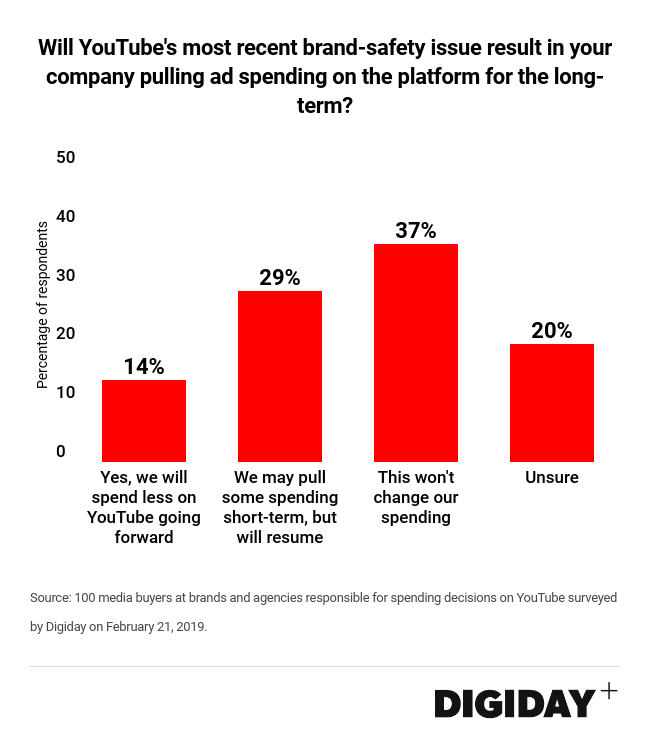‘It’s the human cost’: Buyers shrug at YouTube’s latest brand crisis
As a number of major brands, including Disney, Nestle, McDonald’s, AT&T and Epic Games, are pulling their ads from YouTube due to its latest brand-safety “crisis,” media buyers are largely reacting with a collective shrug.
In a poll conducted by Digiday Research on Thursday, Feb. 21, only 14 percent of 100 buyers said they expect the crisis to have any impact on long-term spending on the platform. Nearly a third of buyers said they expect any cutbacks they make to be temporary. Meanwhile, 37 percent of respondents said the crisis would not impact their advertising plans for the platform.
The latest scandal came about this week when a blogger posted a 20-minute video showing how comments on certain videos showing kids doing gymnastics or posing were used to create what essentially amounted to a child porn or pedophilia ring. Those videos were innocuous on their own, but the comments were used to identify them because they could be seen as sexually suggestive. The way YouTube works, its algorithm would then bring up similar videos.
Brands like Disney and Nestle ran ads on those videos.
But for agency buyers, gathered in Nashville this week for the Digiday Media Buying Summit, this is just the latest in a long line of supposed brand-safety crises that won’t really amount to much other than a temporary pause. “It’ll never happen [that this hurts anyone]. YouTube is such a brand-unsafe environment. But it works. They give you the views, they give you the conversions,” said one C-level exec at a major agency.

For one exec, the issue is time spent worrying about this. Speaking on stage, indie agency Crossmedia’s managing director Ali Plonchak said that one of her largest clients, Hertz, called her up Tuesday and asked for log files to make sure their ads weren’t running on the affected videos. “We went through all this and found that over six weeks we spent 7 cents on any of these videos with comments that have been an issue,” she said. “Of course, we should do this digging, but what did our team not do [while] figuring this out? It’s the human cost. The team didn’t get to spend that time doing optimization or strategy because it was looking for fires.
“It depends also why the issue happened and what your safeguards are in place that should have caught that, and what realistically can catch it,” said Plonchak. “If it helps us to change our process, then that’s a good thing. If it’s an anomaly, what are you supposed to do?”
Louisa Wong, chief transformation officer at Carat USA, said she spent the whole day with clients and Google trying to figure out what next steps were, part of a series of conference calls the company held with holding companies and agencies. One issue was also why YouTube hasn’t done a better job at managing this. Wong said she’s found that buying YouTube inventory through third-party players has meant better controls. “If smaller companies are better at managing this than you are, then that begs some questions,” she said.
This particular crisis pales in comparison with the one in 2017, when investigations by the Times of London and the BBC found ads that ran against comments and videos that exploited children, leading to big brands freezing spend. But even despite the brouhaha then, most brands quietly came back to YouTube. Granted, the Google-owned platform has added certain tools to avoid issues, including pulling off hundreds of thousands of videos off the site and created new tools like Preferred, selling them as brand-safe content zones.
Another issue brought up by agency executives was the scale of the problem in general. Buyers are aware that they have to build in some margin for error — these platforms are too big to expect a “100 percent brand-safe” environment. In that context, it makes it doubly clear that this “crisis” is more about fear of a customer on Twitter making a screenshot of an ad go viral than any actual business concern.
“Our chief digital officer said to our clients if you’re in an environment with audience-based buying, there’s always going to be some exposure,” said Will Warren, who runs digital investment at Zenith. “But [platforms] that have resources need to push them to have products going off the 99.99 percent of safety. Alternatives will come up, and they need to be responsive. And they are. They’re always scrambling. Competition comes from outside; it also comes from within the platforms.
“It’s not Google’s fault. We just need to be live and agile and deal with it, and accept that you can never be 100 percent sure,” said Essence CEO Steve Williams.
“All it takes is one letter from one person saying you were here. People are tweeting at advertisers. It’s fear of the screenshot,” one buyer said.
More in Marketing

How the MAHA movement influenced food and beverage brands in 2025
The MAHA movement has come to stand for different things in different people’s eyes, depending on which initiatives they most closely follow.

Why Georgia-Pacific is turning its programmatic scrutinty to the sell side
The company is turning its attention to the sell side, zeroing in on the ad tech firms that move inventory for publishers — the supply-side platforms.

Future of Marketing Briefing: Why ‘just good enough’ is generative AI’s real threat to marketers
When characters and mascots are allowed to live inside generative systems, they stop being event-based and start becoming environmental.







